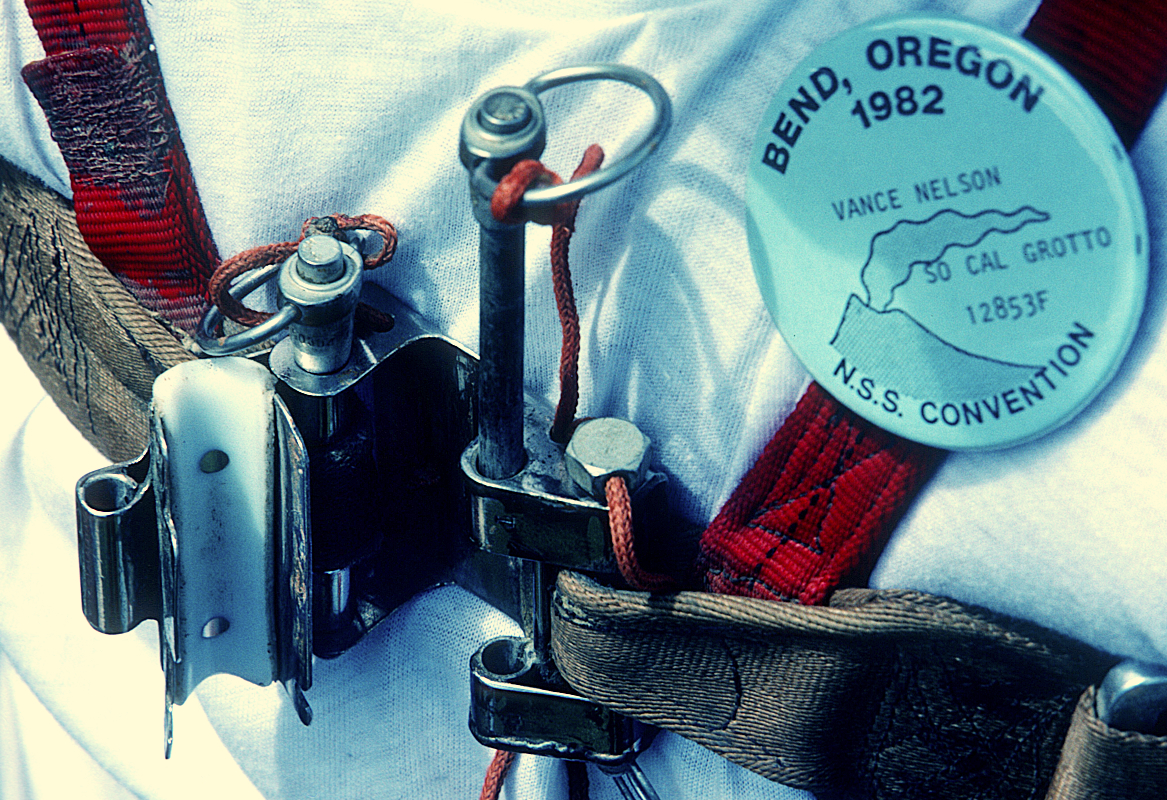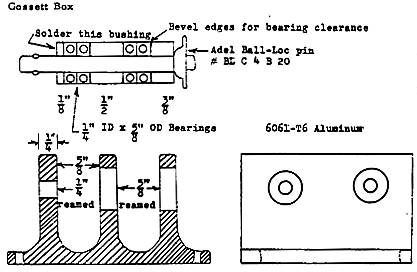Overview
[ Top
| Prototype Box #2
| Prototype Plate
| Return to Chest Boxes
]
Prototype Box #1
(#3769)
Technical Details
I acquired this box from Carol Veseley in 2022.
This unfinished box is 102 mm. wide, 75 mm. high, 39 mm. thick, and weighs 215 g. It is a double channel frame milled from aluminum alloy. It has 51 mm. tall vertical slots for attaching the box to a chest strap. There are no provisions for rollers. Four 1/4-28 UNF threaded holes in the front of the box align with four smaller unthreaded holes in the rear plate. I fabricated wing screws from 304 stainless steel to replace the originals, which were lost to time.
 In 2022, Carol Veseley gave me a number of production and custom Gossett Blocks, along with an assortment of small parts. She had received them from Ray Hardcastle, who had received them from Jim Gossett. This unfinished box was in the assortment. I wrote to Ray and he replied, saying
In 2022, Carol Veseley gave me a number of production and custom Gossett Blocks, along with an assortment of small parts. She had received them from Ray Hardcastle, who had received them from Jim Gossett. This unfinished box was in the assortment. I wrote to Ray and he replied, saying
[This was] a later effort to reduce the bulk of the Gossett Box. Vance Nelson had a lower profile clasp chest box that could hold you close to the rope, but wasn't safe enough for Jim. He was seeking something similar that was safe. He passed away before he perfected it.
Vance's box [photo at right] used a teflon (or polyethylene?) pad that slid along the rope rather than the more traditional rollers. Jim's prototype seems to have relied on the rope sliding along a smooth channel in a similar manner.
Reading that Jim never finished this box, I initially speculated on how he intended to hold the rope and slings inside the box. The four pairs of threaded/unthread holes suggested that he envisioned rods attached to knobs on the front, and this was not far off. I soon remembered Jim's article Evolution of a Chest Block in The Nylon Highway #2, July. 1974 where he described two of his prototype Gossett Boxes. Rather than being an unfinished later version as Ray remembered, this block was Jim's first prototype, dating from 1967, and he had completed it. You can read his description in this excerpt:
The wing screws prove tedious for rigging and derigging. They are not captive, and could easily be lost.
I suspect that the circle and groove at the front were pre-existing in the aluminum block that Jim used for this prototype, and have no practical significance.
[ Top
| Prototype Box #1
| Prototype Plate
| Return to Chest Boxes
]
Prototype Box #2
(#3768)
Technical Details
I acquired this Gossett Block from Carol Veseley in 2022.
This Gossett Block is 85 mm. wide, 63 mm. high, 41 mm. thick, and weighs 276 g.
This Block has a double channel chest box consisting of an aluminum frame with two channels. The frame is significantly narrower than the extruded frame used on the production Gossett Blocks. There are two long 6.4 mm. diameter quick-release pins, each holding a 13 mm. long, brass bushing, two 5 mm. bearings, another 13 mm. bushing, two more bearings, and a final 4 mm. bushing. The bearings and bushing are 18.8 mm. in diameter. The ribs on the frame are drilled to allow seating the QR pin, with 16.1 mm. holes in one lateral and the central rib, and a similar partial hole in the final rib that steps down to 6.5 mm. The harness slots are 52 mm. long and perpendicular to the rear face of the block.
The QR pins are stamped with "AVDEL" and "50304-4-2.100."
Jim Gossett engraved his name on the rear of this plate.
The QR pins make it easy to rig or derig the box, but since the QR pins support rollers in both channels, the design does not provide a convenient means for removing ropes or slings from only one side. This inability is a significant disadvantage in many common practical situations.
Jim described this box in Evolution of a Chest Block in The Nylon Highway #2, July. 1974.
[ Top
| Prototype Box #1
| Return to Chest Boxes
]
Prototype Plate
(#3770)
Technical Details
I acquired this plate from Carol Veseley in 2022.
This plate is 98 mm. wide, 63 mm. high, 19 mm. thick, and weighs 66 g. It is made from 1.45 mm. stainless steel sheet.
This plate is unfinished and any attempt to describe it's intent would be pure speculation. My best guess is that it was to work something like a Blum Box. The workmanship is crude (as on expects on first prototypes) and a bit too flexible for my taste. Jim probably abandoned this idea rather quickly.
[ Top
| Prototype Box #1
| Prototype Box #2
| Prototype Plate
]



 In 2022, Carol Veseley gave me a number of production and custom Gossett Blocks, along with an assortment of small parts. She had received them from Ray Hardcastle, who had received them from Jim Gossett. This unfinished box was in the assortment. I wrote to Ray and he replied, saying
In 2022, Carol Veseley gave me a number of production and custom Gossett Blocks, along with an assortment of small parts. She had received them from Ray Hardcastle, who had received them from Jim Gossett. This unfinished box was in the assortment. I wrote to Ray and he replied, saying

